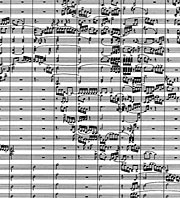Mapping the Score to Planet Earth
Krissy Clark
APRIL 19, 2008
- James Plakovic's Earth map, set to music
- (James Plakovic)
- View the Slideshow
Web Resources
Related Stories
Extra Audio
- Hear and download the full-length version of "World Beat Music"
- Regional sounds of "World Beat Music": Central Asia
- Regional sounds of "World Beat Music": Mideast
- Regional sounds of "World Beat Music:" Hawaii
More From Krissy Clark
Picture your basic map -- a Mercator projection, like the one that used to hang in your social studies class... America is right in the middle, flanked by Africa and Europe on the right. China and Australia on the left. Central Asia's divided at the far ends, half on one side of the map, half on the other. Can you picture it?
OK, now look a little closer -- you begin to realize that on this particular map, the continents are actually made of tiny dots, like a Georges Seurat painting. Look even closer, and you realize those dots are actually musical notes.
"Every land mass has been transformed into musical notation," James Plakovic says. He's the artist behind the map, which he calls World Beat Music. "A note, a rest, a slur, some musical expression mark such as forte or pianissimo, so that the end result, when you step back from the image itself, is that you see land. You see a part of the world."
Plakovic spent six weeks hand-drawing his world map and a musical score. He carefully arranged each note so that, seen from a distance, the notes look like a map of the Earth.
He replaced latitude lines with staff lines. He then divided them up for an orchestra of 37 instruments. Simultaneously, each instrument follows a horizontal cross-section of the map, from west to east.
At the top, near the North Pole, staff lines for woodwinds run across the map. Eighth and sixteenth notes rise and fall along the coastlines of Greenland. Long rests cross the Arctic Sea.
Further down, through the United States, Europe and Asia, there are parts for pianos. The brass section covers the equator, and from the Tropic of Capricorn down to the South Pole are parts for strings.
No orchestra has ever been crazy enough to actually play this map. But recently, Plakovic used a computer program to turn the score into music. He started with just a few of the instrument parts: a flute, two pianos, two violins and a cello.
Plakovic puts his headphones on to listen to the piece -- all 41 seconds of it. He narrates the music as it plays: "We start over in the middle of Asia... The strings section is very sweeping and very beautiful across this particular part of the world." As you enter into Canada, you hear flourishes of piano. "And then you have these two little cellos," Plakovic says. The cellos barely ever go away in the piece, thanks to that quirk of Mercator projection maps that stretches Antarctica into one long stripe across the bottom.
The piece settles down as it sails across the Atlantic, which is made mostly of rests and elided whole notes. As you hit Africa and Western Europe, you get more flourishes of piano. "And then," says Plakovic, "the piece just very nicely comes to an end where it started."
Except that the world is round. So the piece should actually loop, endlessly. That would be fine with Plakovic, because each time you hear the piece, you pick out a new detail.
"Even the Hawaiian Islands, as small as they may be, make it in as five sixteenth notes -- C, E, E, D, D," he says. "And then, where the Big Island is, those are half notes -- C, E, G, and a very high G."
Moments like Hawaii are beautiful on this musical map of the Earth -- if heard in isolation. But when you hear all 37 instruments together, playing every note on the map, things get cacophonous. The notes that make up Michigan have no harmonic relationship to the notes just below them in Central America. Madagascar clashes with the Middle East above it.
"The music is very busy," Plakovic admits. "There are some spots that are flowing and harmonious, and there are definitely areas that are a bit brash and discordant. And that reflects how the world is."
So, did he ever try to make the world more harmonious when he was drawing the map? It might only take a slight adjustment of a note here and a note there...
Plakovic laughs at the suggestion. "If only it was that easy!" he says.







Comments
Comment | Refresh
05/09/2008
The link is to the entire 53 minute show. The relevant segment is 36:20-41:25
From Genoa, IL, 04/19/2008
Great story. James also has done wonderful portraits of famous composers (check out the website) and has been known to give an outstanding lecture or two.
Post a Comment: Please be civil, brief and relevant.
Email addresses are never displayed, but they are required to confirm your comments. All comments are moderated. Weekend America reserves the right to edit any comments on this site and to read them on the air if they are extra-interesting. Please read the Comment Guidelines before posting.
You must be 13 or over to submit information to American Public Media. The information entered into this form will not be used to send unsolicited email and will not be sold to a third party. For more information see Terms and Conditions and Privacy Policy.